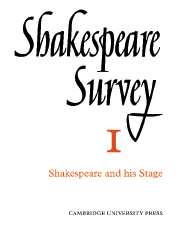Book contents
- Frontmatter
- Studies in the Elizabethan Stage since 1900
- Titus Andronicus on the Stage in 1595
- A Note on the Swan Theatre Drawing
- The Bankside Theatres: Early Engravings
- Shakespeare and the Blackfriars Theatre
- Shakespeare’s Bad Poetry
- The Folger Shakespeare Library
- The Heritage of Shakespeare’s Birthplace
- Three Shakespearian Productions: A Conversation
- Four Lears
- London Productions
- Stratford Productions
- International News
- The Year's Contributions to Shakespearian Study 1 Critical Studies
- 2 Shakespeare’s Life and Times
- 3 Textual Studies
- Books Received
- Index
- Plate section
Studies in the Elizabethan Stage since 1900
Published online by Cambridge University Press: 28 March 2007
- Frontmatter
- Studies in the Elizabethan Stage since 1900
- Titus Andronicus on the Stage in 1595
- A Note on the Swan Theatre Drawing
- The Bankside Theatres: Early Engravings
- Shakespeare and the Blackfriars Theatre
- Shakespeare’s Bad Poetry
- The Folger Shakespeare Library
- The Heritage of Shakespeare’s Birthplace
- Three Shakespearian Productions: A Conversation
- Four Lears
- London Productions
- Stratford Productions
- International News
- The Year's Contributions to Shakespearian Study 1 Critical Studies
- 2 Shakespeare’s Life and Times
- 3 Textual Studies
- Books Received
- Index
- Plate section
Summary
Of one thing in particular Shakespearian scholarship during the past fifty years may justly be proud: only within the present century have we approached within measurable distance of an understanding of the methods employed in the original production of Elizabethan plays or endeavoured to set these plays, in our imagination, firmly against the background of their theatrical environment. No other field of investigation more characteristically belongs to our own age than this.
The Elizabethan Stagein the Nineteenth Century
Even in recognizing the truth of this fact, however, we should not close our eyes to the very real achievements made in this direction by the romantic period preceding our own. Fully a hundred and fifty years ago that vigorous investigator, Edmund Malone, had succeeded in defining some of the main features of the theatres in which Shakespeare had worked. Although he possessed no information about the earliest of all professional London playhouses, the Theatre in Shoreditch, and was not sure when the Globe was built, he knew that the actors originally performed in inn-yards, that the home of Shakespeare's company was round or polygonal, that the audience stood in the yard or sat in the galleries, that dramatic action proceeded both on an upper-stage and on a lower and that the plays were graced with few or no scenic embellishments.
Following Malone came numerous other scholars, each intent on unearthing documentary material, each adding his discoveries to the common store: Collier, Cunningham, Halliwell- Phillipps and others thus actively added to the accumulation of knowledge until, by the century's end, men had a very fair general conception of the way in which the Elizabethan stage differed from the kind of theatre made colourful by an Irving and a Tree.
- Type
- Chapter
- Information
- Shakespeare Survey , pp. 1 - 16Publisher: Cambridge University PressPrint publication year: 1948



